
42 minute read
Efficient Cargo Operations
from Wavelength #69
Marine Operations
EFFICIENT CARGO OPERATION Reducing the cargo discharging period
Advertisement
It is of the utmost importance to keep the cargo discharging period to a minimum and, therefore, minimize berth occupancy time. Oil terminals worldwide have set limits of berth occupancy time depending on the size of the oil tanker and the quantity of cargo. A violation of the maximum occupancy time reflects negatively on the ship’s reputation. Oil terminals may ban oil tankers which repeatedly violate the maximum berth occupancy time. The discharging rate can only be constrained by the oil terminal’s requirements. The ship’s equipment involved in cargo discharging must operate flawlessly without leakages, in automatic mode and at the rated output in order to discharge the cargo in the minimum possible time.
Cargo Oil Pumps
Centrifugal pumps are to be run at their full nominal RPM during bulk discharge. A reduction in RPM leads to a rapid decrease in both the pumping rate and pumping efficiency. Lowering the RPM of the cargo pumps prolongs the discharging period and results in higher fuel consumption in the auxiliary boilers and diesel generators. The cargo oil discharge plan should be carefully prepared to allow for the oil terminal’s constraints (maximum flow rate and back pressure). Extra care is required when operating centrifugal pumps in parallel in order to avoid the overheating of any pump lagging behind the other two in terms of discharge pressure. Ensure that all pumps are operating at the same speed and discharge pressure. Please refer to Wavelength issue 66, article: “Efficient Operation of Centrifugal Cargo Oil Pumps”
Ballast pump driven by electric motor at the rated rpm of the AC motor
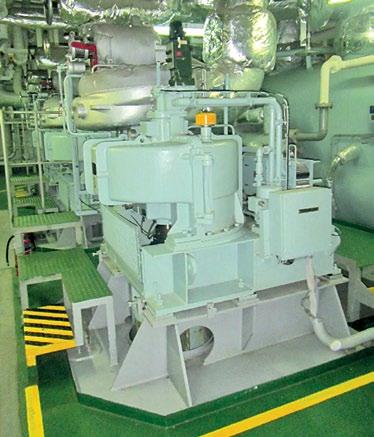
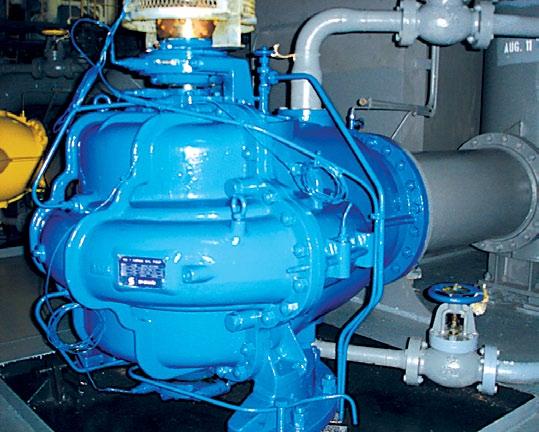
Cargo pumps are driven by steam turbines and must be operated at the rated speed according to the pump’s particulars.
Automatic Unloading System
In order to facilitate discharging operations, ships are fitted with an Automatic Unloading System (AUS) that extracts vapour and gas produced as a result of the liquid level lowering in the tank. The various components of the AUS should be properly inspected and maintained according to the Planned Maintenance System to ensure that it will operate satisfactorily. A malfunctioning or non-operating AUS will result in longer discharging periods and damage to the cargo pump due to dry running of the pump.
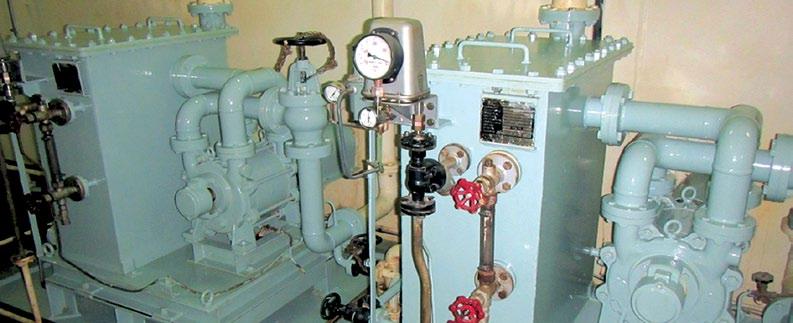
Automatic Cargo Unloading System (AUS)
Vacuum Condenser
Exhaust steam from the cargo pump turbines is condensed under vacuum in the sea water cooled vacuum condenser. The vacuum in the condenser is maintained by steam driven venture type air ejectors. The water level in the condenser is maintained by a three - way automatic level control valve and the condensate water pumps. The vacuum condenser structure is safeguarded against overpressure either by a safety valve or a burst disc. Both air ejectors must be used to raise an adequate vacuum in the condenser to ensure proper steam exhaust from the steam turbines. Air ejectors, nozzles and venturis, air traps, steam traps and steam strainers must be periodically cleaned according to the Planned Maintenance System (PMS). These components can be easily blocked by scale, rendering the air ejectors inoperable. Condensate pumps and the components of the automatic level control of the condensate must be maintained according to the PMS. Optimum performance of the vacuum condenser and proper maintenance of the associated equipment is absolutely essential if an adequate vacuum is to be raised and the cargo pumps are to be operated at the rated RPM.
Atmospheric Condenser
The atmospheric condenser is a heat exchanger which removes the latent heat of steam returning from various consumers such as stripping pumps, the heating coils in the bunker and cargo tanks and deck seal heating etc. so that it condenses and can be pumped back into the boiler. The atmospheric condenser is a very important piece of equipment which has to be operated and maintained properly so as to avoid blockages and the corrosion of tubes. Problems usually encountered: - Blocked tubes due to inadequate cooling water supply or excessive marine growth - A malfunctioning Marine Growth Prevention
System (MGPS) indicated by excessive marine growth in way of sea water lines - Severe corrosion of tubes and tube plates due to a lack of maintenance and timely replacement of sacrificial zinc anodes Excessive corrosion results in holes in the condenser tubes, increased salinity of the boiler feed water, an inability to control the boiler water level, water carry over to the steam turbines, stoppages during cargo discharging operations and ultimately corrosion of the boiler tubes and impingement erosion of the steam turbine blades. Blocked or plugged tubes reduce the capacity of a condenser, leading to excessive steaming in way of the cascade tank. The atmospheric condenser must be operated and maintained according to FIM & PMS to avoid the blockage and corrosion of tubes, delays during discharging and costly repairs (boiler retubing, cargo pump steam turbine rotor reblading, condenser retubing)
Vacuum Condenser
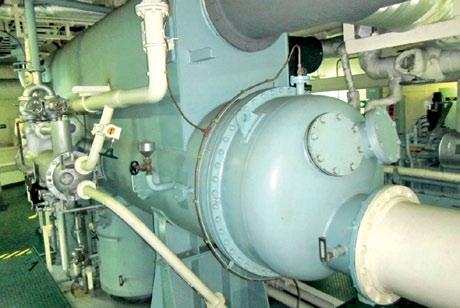
Air ejector to raise the vacuum in the Vacuum Condenser
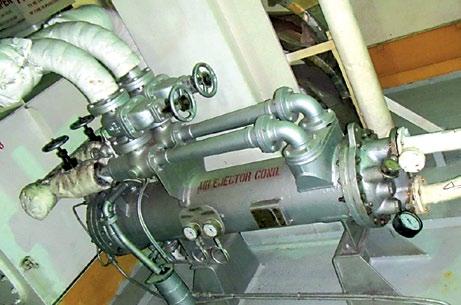

Atmospheric condenser

Heavily fouled and corroded atmospheric condenser

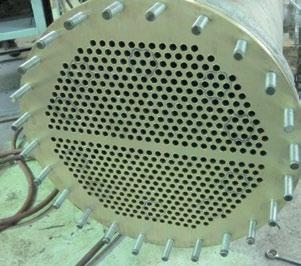
Manning and Training
Positive Coping Statements Help Overcome Difficult Situations
It is the case that in times of distress we block ourselves with negative selftalk, which does not help at all. We can try to use thought-stopping strategies, but unless we have got a ready thought replacement, it probably won’t work (the mind’s not so good at staying quiet). On the other hand, positive coping statements encourage us and help us cope through distressing times. We can say these encouraging words to ourselves and be our own personal coach. We have all survived some very distressing times, and we can use those experiences to encourage us through current difficulties. Coping statements are truthful positive statements used to replace the negative thoughts that take over when you feel anxious, stressed, angry and/or when you face other overwhelming situations. For example, instead of stating "I can't take it anymore.", you can use "This is uncomfortable, but I can handle it if I take slow and deep breaths." Verbalizing your coping statements can help you calm down and stay in control. They offer reassurance that you can make it through any difficult period. That is why preparing positive coping statements and writing them onto coping cards that you carry with you makes sense. Whenever negative self-talk gets you down, pull out your coping card and read your positive affirmations until you feel better. It sounds too simple to work, but it does work, and since it’s so simple, you can make your own cards right now. However, a coping statement can only have positive results if it comes from within and reflects reality. For example, when there is anxiety before an operation or a task that is hazardous, a positive coping statement can only work and boost a Seaman’s confidence when he has taken all the necessary precautions, has assessed all risks and has ensured that it is safe to proceed by following all safety procedures. Because it can be difficult to remember your coping statements once you start feeling overwhelmed, it is helpful to write out a number of statements on a small card that you can carry around easily in your wallet at all times. With this card on your person at all times, you can pull it out and read the statements to yourself whenever you need to. You may want to write out different cards for different situations that provoke anxiety, panic or whatever you struggle with. The cards work best when filled with statements that are specifically applicable to you and to the situations you face. Here are some useful tips for writing/using effective coping statements: To begin with, write the statements in your own words and use language you feel comfortable with, avoiding formal or academic language. Also, write statements that specifically target your problem. For instance, if you have anxiety about a bladder problem, write specifically about that. What is more, please ensure that the statements you write are not only reassuring, but also realistic and truthful. If you struggle with pain, repeating, “I don’t feel pain” probably won’t help as you are unlikely to ‘fool’ yourself. A more accurate and, thus, more useful statement, might be, “This pain won’t last forever.” Last, but not least, keep statements brief and easy to memorize so that you won’t have trouble remembering and repeating your statement when feeling overwhelmed. Coping statements are used whenever you feel the onset of anxiety, panic or feelings of being overwhelmed. You can read them out loud, if possible, and repeat them until you start to feel better. If one statement in particular helps calm you most, just continue to repeat that statement to yourself – like a mantra. Always remember to breathe slowly and deeply into your diaphragm as you read your statements. During a distressing situation, it is important to remain calm and support yourself with kind words so that you make it through. Remember that you are your most valuable supporter. In the event, however, you feel you cannot provide yourself with a positive coping statement, please ask for help from a friend or fellow worker that has positive thoughts and will be glad to assist you. In any case, may we also remind you that in times of distress, you can always seek support on a confidential support line, namely Mindcall at +44 1912353917 or visit www.mindcall.org
Sources: https://www.choosehelp.com/topics/mental-health/rehab-for-patients-withmental-health-challenges • ISWAN booklet on Seafarers’ Health Information Programme – Steps to Positive Mental Health

Manila Forum
February 2019
As is now customary, CENMAR Manila organized a Forum in February to complement the established November one. The two-day event was held in the Sofitel Philippine Plaza Hotel and it focused on the company’s motto for the year:
“BE AWARE, TAKE CARE – EVERY TIME, EVERYWHERE”.

The first day included presentations relating to everyday operations for deck and engine officers. The second day targeted subjects such as Goal Zero and Safety Culture, which were addressed to all crew members. The Forum was chaired by Yannis K. Prokopiou Head of the M&T dept., and head office was represented by Anthony Lambros (DPA), Dimitris Sarantis (Technical Reporting Supervisor), Elli Moretti (Deputy DPA), Andreas Chandris (Operator), Panagiotis Bartzis (M&T dept.), and Capt. Rommel Reyes (SBTRN). External speakers included Dr. Glennda Canlas of the Halcyon Clinic and Commander Eugenio A. Federico of the Manila PSC unit. At the end of the Forum, a gift of appreciation was presented to the following seafarers in recognition of their long and loyal service:
Rank /Name Capt. SABAN, George C/M VELASCO, Elmer 3/E BULAY, Danilo 3/E DIGNADICE, Kitch Bryan BSN RIZALDO, Francisco C/COOK CONCEPCION, Jimmy Years with CENMAR 22 26 23 14 28 29 An interactive exercise inspired by Shell’s Partners in Safety Program called “Observing Differently” was presented in this Forum, and most attendees appeared to be excited to participate and test their observation skills.

Participating in the “Observing Differently” exercise At the end of the first day, all the participants met in downtown Manila for the traditional basketball game. The CENMAR Warriors played against CENMAR Bucks for the trophy in a full length match. In a very exciting game, the Bucks scored first and kept the lead until the end, eventually winning 107-95. Despite never taking the lead, the Warriors lived up to their name by fighting back and pushing the Bucks to their limit. As the final score shows, the CENMAR Bucks may have won the trophy, but the real winners were the players and spectators of a really good basketball game.
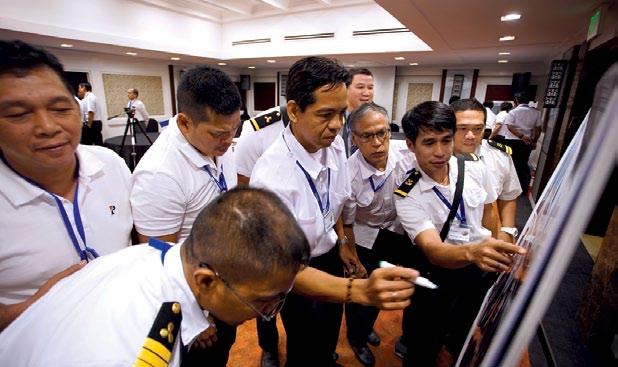

SAFETY FIRST! Safety Bulletin
Message from the DPA
Dear seafarers,
When we think philosophy, we think Greece, and we usually think of Socrates, Aristotle and Plato. However, even before this remarkable trio, there was a Greek philosopher named Heraclitus, who was a self taught pioneer of wisdom. He is remembered for his firm belief that change is ever-present and is the fundamental essence of the Universe. His quotes survive in subsequent works by Plato and others, the most famous of which are: “No man steps in the same river twice, for it’s not the same river, he’s not the same man”, and, “Nothing endures but change”. The reason why I am going back 2500 years is because this remains ever so relevant today. Change is present everywhere. There is continuous change in our work, in our private lives, in our relationships and even in the air we breathe. It surrounds all of us and change is now occurring at such a pace that we are having a hard time keeping up. Technology has made coping with change even more challenging which you as seafarers understand very well. We cannot avoid change. However, we can manage it. How we manage change will determine how successful we will be. As such, we have created specific procedures to deal with change, and it is extremely important that we all adhere to these. Whether engaging a big or small operation or activity, we must fully acknowledge the fact that others are affected and, therefore, we need to undergo a Management of Change procedure (MoC) so that we take the precautionary measures necessary to ensure that any risks arising from change are mitigated. I, therefore, ask you to keep in mind the teachings of Heraclitus, embrace change as it is part and parcel of life, and always manage change in a way that reduces risk. Times are changing and there is no avoiding the challenges they bring. Be Aware, Take Care, Every Time, Everywhere & Wishing you safe seas.
Anthony Lambros - Director & DPA
I welcome your comments, suggestions or feedback on the contents of this column (Safety First!) at q&s@centrofin.gr.
Goal Zero & Near Miss reporting: Let’s combine them in favour of our safety culture!
1. Unsafe condition 2. Unsafe act 3. Near miss 4. Accident
» If we are able to spot unsafe conditions, it is very likely that we can avoid an unsafe act, near miss and accident. » If we are able to alert each other and have high safety awareness, we will be able to stop the unsafe act, thereby avoiding the near miss and accident. » If we miss the two first opportunities, we still have one more chance to avoid the accident. Report and discuss the near miss in order to prevent personal injury or other accidents.
Observe Differently!
Examples of
ACTS
UNSAFE • Working without PPE • Carrying stuff using both hands on stairways or while the vessel is rolling • Using defective equipment
• Not consulting a Work Permit prior to and/ or during a task Examples of
CONDITIONS
UNSAFE • Oily rugs left unattended • Working tools and equipment lying around or on stairs • Unsecured items onboard (in the Galley, on Deck, in the Engine Room, in stores) • Scuppers not tightly plugged • Appliances left "switched on" • Unsecured gym apparatus • Emergency equipment misplaced or obstructed
Analyze Near Misses like the Accident that could have happened!
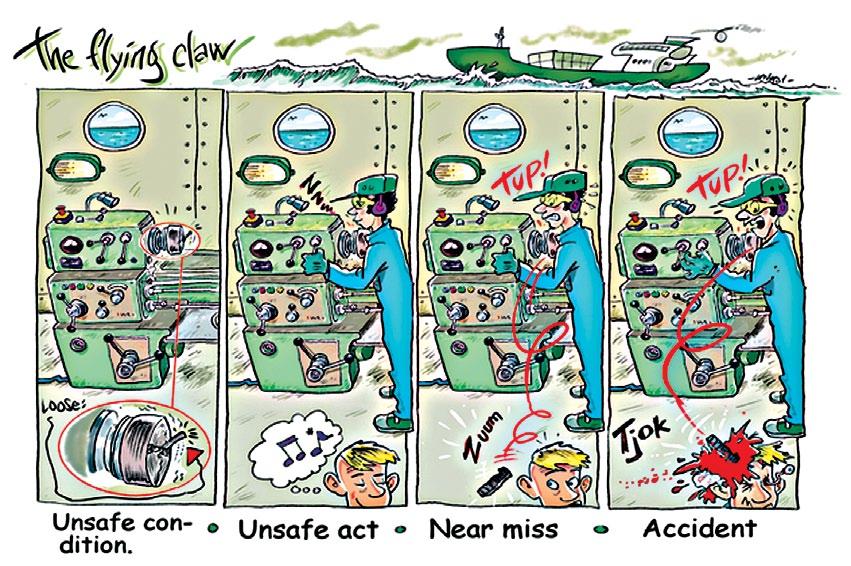

EXAMPLES REAL ROOT CAUSES • Lack of Supervision • Failure to follow procedures • Poor work planning • Insufficient instructions/ procedures
So what if it is just a near miss? It needs to be out in the open for the whole fleet to benefit from the lessons learned. The investigation and root cause analysis of a near miss must not be taken lightly! It is very easy to find the actual root causes: a. Identify all the causes (big/small, direct/indirect). b. For each direct cause ask “Why?” This generates more possible reasons /causes. c. When you find an answer, repeat the question “Why?” until the root cause is apparent. d. Typically five rounds of “Why?” questions are enough to find the real root causes.
The WHY method should be used in ANY type of incident investigation
TRUST: TEN Really Useful Safety Tips Weak Signals of Unsafe Acts & Conditions
The ones above are simple examples, but sometimes Unsafe Acts & Unsafe Conditions are not easy to spot! Identify and correct the unsafe acts and conditions which are hard to see in your daily work:
1. Complacency. You have done it many times before and there has never been an accident, so why should it be dangerous? 2. Recklessness. This will undermine all safety procedures in place. 3. Risk Normalization. If the leaders on board do not intervene when unsafe acts are observed, such behaviour will be perceived as "the way people do things around here". 4. There is defective equipment or machinery components in plain sight, but everybody is used to such conditions, so no one reports them or takes action to correct them. 5. When spotting an unusual situation, the observer believes that it is someone else’s job to report it. 6. There is a superficial risk assessment that the ratings do not take responsibility for. 7. There is a poorly written procedure that does not comply with how operations should be conducted. 8. There is an onset of fatigue which affects the way people react or think. 9. There are actions that involve taking shortcuts and prevent people from stopping to think before doing the job. 10. There is a lack of training / familiarization that can contribute to people not being skilled on the job, thereby putting themselves and others in danger.
WITH LESSONS LEARNED SHARED THROUGH THE INDUSTRY
Title: 1 NEAR MISS, 1 UNSAFE ACT AND 1 UNSAFE CONDITION CASES WITH LESSONS LEARNED SHARED THR OUGH THE INDUSTRYTitle: 1 NEAR MISS, 1 UNSAFE ACT AND 1 UNSAFE CONDITION CASES WITH LESSONS LEARNED SHARED THR OUGH THE INDUSTRY
Source: Safety at Sea Source: Safety at Sea 1. NEAR MISS: PUMPS START DURING CRANKCASE INSPECTION
1. NEAR MISS: PUMPS START DURING CRANKCASE INSPECTION1. NEAR MISS: PUMPS START DURING CRANKCASE INSPECTION The crew were about to carry out a routine crankcase inspection of the main engine when its lubrication oil pumps suddenly started due to a change of the The crew were about to carry out a routine crankcase inspection of the main engine when its lubrication oil pumps suddenly started due to a change of The crew were about to carry out a routine crankcase inspection of the main engine when its lubrication oil pumps suddenly started due to a change of control system mode from port to sea. No crew were inside the crankcase at the time. Had they been, they would have suffered serious injuries. the control system mode from port to sea. No crew were inside the crankcase at the time. Had they been, they would have suffered serious injuries.the control system mode from port to sea. No crew were inside the crankcase at the time. Had they been, they would have suffered serious injuries. The cause: Despite the fact that a work permit issued to the crew clearly stated that the main engine's lubrication oil pumps should be switched off and The cause: Despite the fact that a work permit issued to the crew clearly stated that the main engine's lubrication oil pumps should be switched off and The cause: Despite the fact that a work permit issued to the crew clearly stated that the main engine's lubrication oil pumps should be switched off and isolated before carrying out the crankcase inspection, this was ignored and the pumps were not switched off on the electrical switchboard.isolated before carrying out the crankcase inspection, this was ignored and the pumps were not switched off on the electrical switchboard.isolated before carrying out the crankcase inspection, this was ignored and the pumps were not switched off on the electrical switchboard. Lessons Learned: Work permits should be followed to ensure safe operations. Ignoring them can turn even an everyday job into a dangerous one. Never Lessons Learned: Work permits should be followed to ensure safe operations. Ignoring them can turn even an everyday job into a dangerous one. Never Lessons Learned: Work permits should be followed to ensure safe operations. Ignoring them can turn even an everyday job into a dangerous one. Never start any job before you have checked that the machinery has been switched off and isolated.start any job before you have checked that the machinery has been switched off and isolated.start any job before you have checked that the machinery has been switched off and isolated.
2.2. UNSAFE ACT: IMPROPER POSITION OF HAND UNSAFE ACT: IMPROPER POSITION OF HAND
While finishing a piston pull in the engine room, the crew were to fit the piston back in the cylinder. The engineer responsible for keeping the stuffing box While finishing a piston pull in the engine room, the crew were to fit the piston back in the cylinder. The engineer responsible for keeping the stuffing box in place and making sure that it was aligned kept his hand in an unsafe location below the box. As the stuffing box was not supported in any way, this in place and making sure that it was aligned kept his hand in an unsafe location below the box. As the stuffing box was not supported in any way, this could have dropped under its own weight and crushed his fingers. could have dropped under its own weight and crushed his fingers.
The cause: Poor planning was found to be the main root cause. The focus was on completing the job in good time rather than on safety. Poor The cause: Poor planning was found to be the main root cause. The focus was on completing the job in good time rather than on safety. Poor communication between the engineer inside the scavenge space and the person controlling the crane exacerbated the situation. communication between the engineer inside the scavenge space and the person controlling the crane exacerbated the situation.
Lessons Learned: In all tasks, whether they are routine or special jobs, time should be taken to do a proper tool box talk, covering all aspects of the job to Lessons Learned: In all tasks, whether they are routine or special jobs, time should be taken to do a proper tool box talk, covering all aspects of the job to make sure everything is safe to continue. During a longer, time consuming job such as a piston pull, it may be possible to split up the tool box talk, with make sure everything is safe to continue. During a longer, time consuming job such as a piston pull, it may be possible to split up the tool box talk, with each part focused on the next task.each part focused on the next task.
3.3. UNSAFE CONDITION: FAULTY FIRE ISOLATION VALVEUNSAFE CONDITION: FAULTY FIRE ISOLATION VALVE
When isolating fire valves before hydrant maintenance, the 3rd officer found the aft isolation valve extremely difficult to close. It took only 3 turns to close When isolating fire valves before hydrant maintenance, the 3rd officer found the aft isolation valve extremely difficult to close. It took only 3 turns to close it fully. When he investigated further, he found that it would only partly open to a maximum of three turns, when it should take 11.5 turns to fully open or it fully. When he investigated further, he found that it would only partly open to a maximum of three turns, when it should take 11.5 turns to fully open or close.close.
The cause: It was found that rust had built up on the inside of the spindle. This was causing it to jam when only partly open. The issue was only with the The cause: It was found that rust had built up on the inside of the spindle. This was causing it to jam when only partly open. The issue was only with the aft valve, which was not instantly noticeable due to its location. All isolation valves are supposed to be opened and closed fully during the routine safety aft valve, which was not instantly noticeable due to its location. All isolation valves are supposed to be opened and closed fully during the routine safety rounds every week. As all the other valves were found to be free, it was likely that this valve was overlooked for at least a few months. The main cause rounds every week. As all the other valves were found to be free, it was likely that this valve was overlooked for at least a few months. The main cause was a personnel change during which handover was not as clear as it should have been. was a personnel change during which handover was not as clear as it should have been.
Lessons Learned: When performing routine tasks it is easy to switch to autopilot and carry out checks that are not meaningful. Presence of mind and lack Lessons Learned: When performing routine tasks it is easy to switch to autopilot and carry out checks that are not meaningful. Presence of mind and lack of rush are very important for all routine checks, even for the simplest of tasks. Checklists filled in with ticks but without actual checking the items can of rush are very important for all routine checks, even for the simplest of tasks. Checklists filled in with ticks but without actual checking the items can lead to serious consequences. lead to serious consequences. BarrierspreventtheHazardfrombecominganIncidentBarrierspreventtheHazardfrombecominganIncident
ARE YOUR BARRIERS ARE YOUR BARRIERS STRONG?STRONG? What are the barriers What are the barriers that prevent injury that prevent injury during maintenance during maintenance works in the E/R? works in the E/R? When all your barriers When all your barriers don’t work properly at don’t work properly at the same time... the same time... the holes line up.the holes line up.
Then the hazard Then the hazard passes through and passes through and results in an incident!results in an incident!
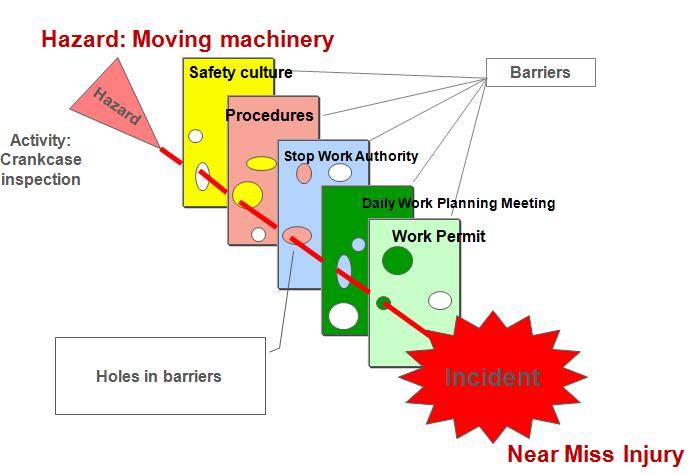
2. UNSAFE ACT: IMPROPER POSITION OF HAND While finishing a piston pull in the engine room, the crew were to fit the piston back in the cylinder. The engineer responsible for keeping the stuffing box in place and making sure that it was aligned kept his hand in an unsafe location below the box. As the stuffing box was not supported in any way, this could have dropped under its own weight and crushed his fingers. The cause: Poor planning was found to be the main root cause. The focus was on completing the job in good time rather than on safety. Poor communication between the engineer inside the scavenge space and the person controlling the crane exacerbated the situation. Lessons Learned: In all tasks, whether they are routine or special jobs, time should be taken to do a proper tool box talk, covering all aspects of the job to make sure everything is safe to continue. During a longer, time consuming job such as a piston pull, it may be possible to split up the tool box talk, with each part focused on the next task. 3. UNSAFE CONDITION: FAULTY FIRE ISOLATION VALVE When isolating fire valves before hydrant maintenance, the 3rd officer found the aft isolation valve extremely difficult to close. It took only 3 turns to close it fully. When he investigated further, he found that it would only partly open to a maximum of three turns, when it should take 11.5 turns to fully open or close. The cause: It was found that rust had built up on the inside of the spindle. This was causing it to jam when only partly open. The issue was only with the aft valve, which was not instantly noticeable due to its location. All isolation valves are supposed to be opened and closed fully during the routine safety rounds every week. As all the other valves were found to be free, it was likely that this valve was overlooked for at least a few months. The main cause was ACCIDENTS ARE PREVENTABLE! ACCIDENTS ARE PREVENTABLE! a personnel change during which handover was not as clear as it should have been. Take action on the near misses that occur because you will simply not accept accidents aboard. The better we are at sharing our knowledge Take action on the near misses that occur because you will simply not accept accidents aboard. The better we are at sharing our knowledge about how things go wrong, the fewer accidents there will be at sea until we reach Goal Zero!about how things go wrong, the fewer accidents there will be at sea until we reach Goal Zero!Lessons Learned: When performing routine tasks it is easy to switch to autopilot and carry out checks that are not meaningful. Presence of mind and lack of rush are very important for all routine checks, even for the simplest of tasks. Checklists filled in with ticks but without actual checking the items can lead to serious consequences.
ACCIDENTS ARE PREVENTABLE!
Take action on the near misses that occur because you will simply not accept accidents aboard. The better we are at sharing our knowledge about how things go wrong, the fewer accidents there will be at sea until we reach Goal Zero!
May 2019

CENMAR Mumbai and Marine Trust staff full of enthusiasm
Following last year’s successful event, the Mumbai Forum was held in the Grand Hyatt Hotel on 22nd & 23rd May. It was a very pleasant and interesting event with opinions, ideas and suggestions being shared openly. The dinner party attended by the seafarers with their wives and children was especially successful, and it provided everyone with the opportunity to meet each other in a relaxed and cheerful environment.
The dinner was an excellent opportunity to socialize The agenda included a wide variety of topics such as bunkering operations, PSC inspections, navigational incidents, voyage management, closed cargo operations and energy efficiency. In addition, safety / behavioural subjects such as root cause analysis, chronic unease, weak signals, and hazards and barriers were presented. The “Observing Differently” session was carried out with great success. The aim of this session was to demonstrate that observing both in detail and from a different perspective are very important. Finally, Capt. Sunil Pradhan, former Vice President of Reliance, presented Oil Terminal Operations and Expectations from Vessels, and Mr. Gabriel Dovles of TQC gave presentations about Cyber Security, UMS Operations and OWS Systems & Records.
Observing Differently The Forum was chaired by Yannis K. Prokopiou, Head of the M&T dept., and head office was represented by Anthony Lambros (DPA), Dimitris Sarantis (Technical Reporting Supervisor), Elli Moretti (Deputy DPA), Fivos Christopoulos (Senior Operator), Eleftheria Lemontzoglou (Operator), Capt. Delson Roche (SBTRN) and Capt. Prashant Kumar. At the end of the forum, a gift of appreciation was presented to the following officers and crew members for their long and loyal service:

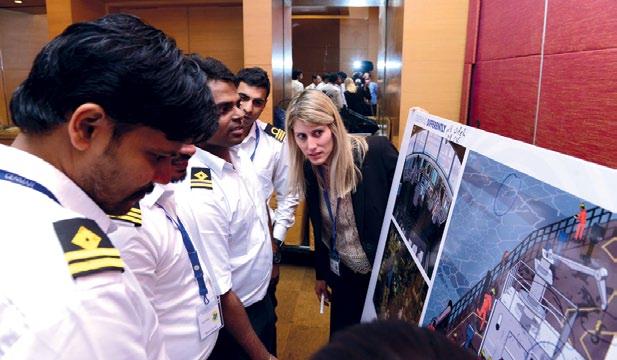
Rank / Name
Capt RAIKWAR MOHAN LAL With CENMAR
since 2006
C/O MOHANGANDHI MUGUNTHA KUMAR since 2005
2/E TAMBOLI SADIK ALI SIKANDAR since 2006
TR. MASTER KUMAR DHARMENDRA since 2008
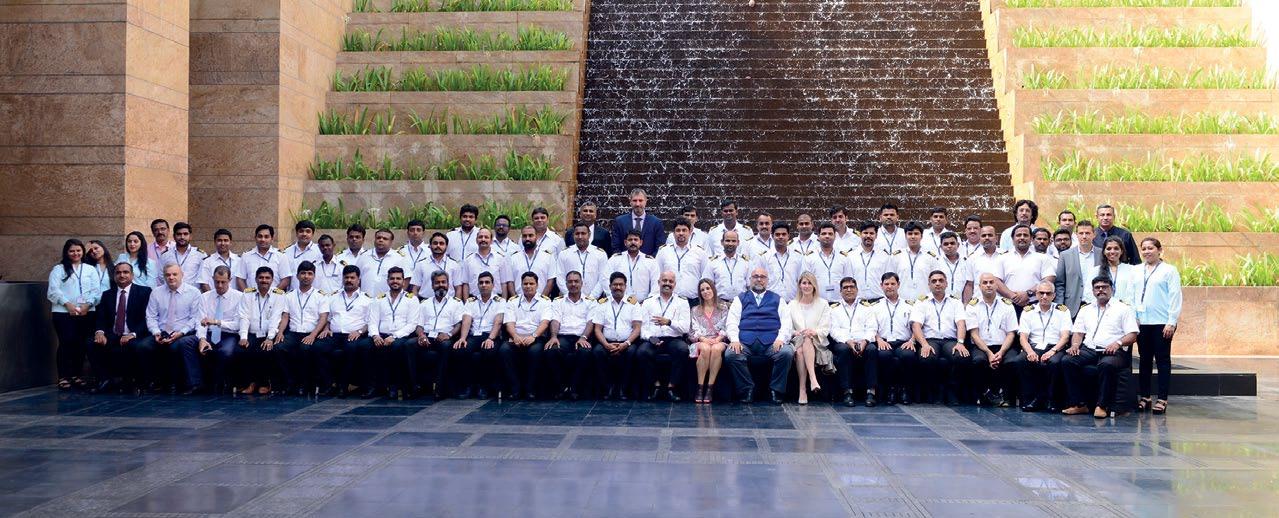
Culture Corner
The Cornish Gig: a boat with a legacy
Origins
The name of this traditional boat is believed to have been derived from the word “gigge” or its adjective “giggish” meaning light/flighty – lexical items that can be traced back to the early thirteenth century. The boat, however, dates back to the end of the seventeenth century. Specifications
The gig is a six-oared rowing boat. Constructed from Cornish narrow leaf elm, it is 32ft (9.8m) long and has a beam of 4’10” (1.47m). Its design allowed it to live up to the word from which its name was derived. Indeed, it was so difficult to catch (when engaging in unlawful activities) that the customs and excise authorities declared it illegal to construct gigs that could accommodate over six oarsmen.
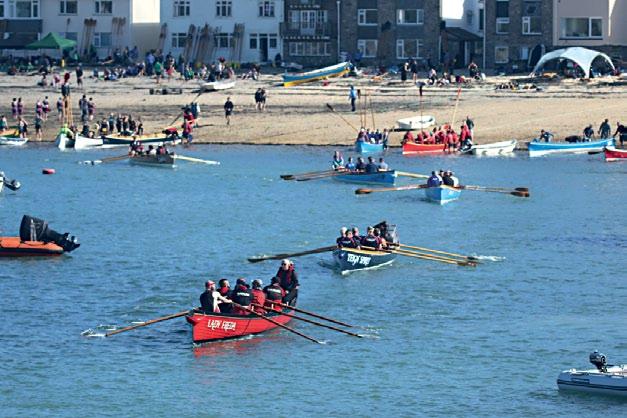
Lady Freda and Teign Spirit lead away from the harbour at St Mary's, Isles of Scilly, during the world pilot gig championships
By Andrewrabbott – Source: www.wikipedia.org
Purposes
The original purpose of the gig was to take pilots to incoming vessels in the Atlantic. These vessels would often be in difficulty, so the gig crew faced obvious dangers. Gigs would also be used to transport goods to land when the destination harbour was too small or too risky for the vessel to reach. Additionally, gigs might be described as early lifeboats because they participated in numerous rescues. Lastly, they were known to have been involved in smuggling operations (the aforementioned unlawful activities). Gigs in Action
Despite the dangers associated with working on a gig, there was no shortage of men willing to venture out onto the sea to make the most of the lucrative ‘gig business’. Figures support this conclusion as there were about 200 gigs operating around Cornwall and the Scilly Isles in the early nineteenth century. As regards pilots, there were some 200 working in the same region in the middle of the same century. These numbers clearly show that there was intense competition among gig crews. Since only the first gig to deliver the pilot to the incoming vessel would receive payment, races were not uncommon. Therefore, tipsters entered the equation. These people would gather information about ships entering the waters around Cornwall from the Atlantic and sell it to a gig crew that wished to gain a significant advantage. The crew would then stealthily launch their gig (more often than not under the cover of darkness) while their rivals slept. Stones of rescues abound, but one stands out for the lengths a crew went to carry out this duty: “Strong winds prevented the crew of Albion gig on Bryher from launching on the western shore to aid the steam ship Delaware in 1871. So, they carried the half-tonne gig for half a mile overland, rowed to Samson, and then carried it overland again before rowing to rescue passengers." Gigs would also race against each other for a cash wager. Such races could be for up to £12, landing each victorious oarsman £2. This was a significant amount back in 1850!
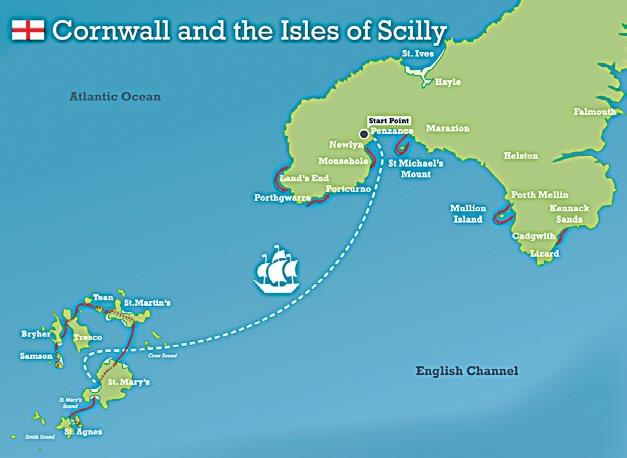
Area where pilot gigs operated and now race
Source: www.swimtrek.com
Today
The cultural heritage of the gig lives on in modern times in the form of gig racing. Unlike the pilot-ferrying work of the gig, which diminished after WWII, racing has flourished in recent years. There are an estimated one hundred clubs in the world from nearby France and the Netherlands to countries further afield such as the Faroes, Bermuda, the US and Australia. Around 150 gigs line up for the annual World Pilot Gig Championships to compete for the coveted trophy. Incidentally, all the modern racing gigs are based on the “Treffry” (design), which was built in 1838 by William Peters of St Mawes near Falmouth. This historic boat is owned and still raced by Newquay Rowing Club. Additionally, gig boats are constructed at the Maritime Museum in Falmouth, Cornwall and scale models are on display at the National Maritime Museum in Greenwich, London. The fact that the gig lives on ensures that the bravery of the Cornish rowers of the past will not be forgotten.
Sources: www.ngrc.co.uk, www.visitislesofscilly.com, www.collections.ring.co.uk, www. indipendent.co.uk
Speed Limits in the Panama Canal
On 1st August 2019 ships in specified areas of the Panama Canal should not proceed at a speed greater than 10 knots. This limit will remain in force until 30th November 2019. The limit has been imposed as an implementation of the IMO’s recommendations on both speed and maritime transit that are intended to protect large aquatic mammals such as whales and dolphins during their seasonal migration in the region. As regards transit, Panama has been monitoring the recommendations since December 2014, when the country introduced Traffic Separation Schemes (TSS) for vessels approaching the entry points to the Canal from both the Caribbean Sea and Pacific Ocean. The aforementioned routes have been chosen been chosen so as to minimize the overlap of shipping lanes and whale migration routes. As such, global shipping charts have been updated to allow for the required alteration. These changes along with the speed limit in specified areas may seem to be some kind of compromise, but nothing could be further from the truth. Researchers explored numerous technological methods to reduce the risk of collisions with cetaceans, but not one was viable. Some even made whales surface, putting them at greater risk. One factor that prevented other potential methods from being adopted is the “bow null effect”, where engine noise is blocked by the bow, thereby creating a quiet zone and putting a whale in greater danger. Apart from research working on the best way of protecting cetaceans during migration, the Panama Canal Administration and environmental specialists made a joint effort to reach the best possible solution for all parties concerned. Moreover, it was abundantly clear from the press releases that there is mutual respect for the goals and objectives of the maritime industry and environmentalists. Panama Canal Administrator, Jorge L. Quintano, reiterated the PC’s commitment to biodiversity “by encouraging the maritime community to follow the recommendations and guidelines established by existing maritime traffic devices”. Panama Canal Environmental Specialist, Alexis Rodriquez, also recognized the importance of incorporating recommendations and guidelines in order to protect cetaceans. He emphasized the significance of cooperation by stating that “the joint work and the holistic approach of the Canal’s Green Route not only promote the preservation of biodiversity but also contribute to national conservation efforts through commitments made to the IMO and international maritime transport community”. This initiative undertaken by the Panama Canal is by no means an isolated instance of environmental concern. Instead, it is just part of the Canal’s efforts to implement environmental stewardship. Among the other initiatives are watershed conservation, water-saving basin innovations and programmes specifically aimed at the reduction of greenhouse gas emissions through the implementation of new technologies and standards.

Pacific side entrance
Courtesy of: Camilo Molinaderivative. Source: commons.wikimedia.org
Sources: www.ship-technology.com, www.marineinsight.com, www.gcaptain.com, news.mongabay.com
Humpback Whale: One of the species benefiting from the Canal’s imposed speed limit
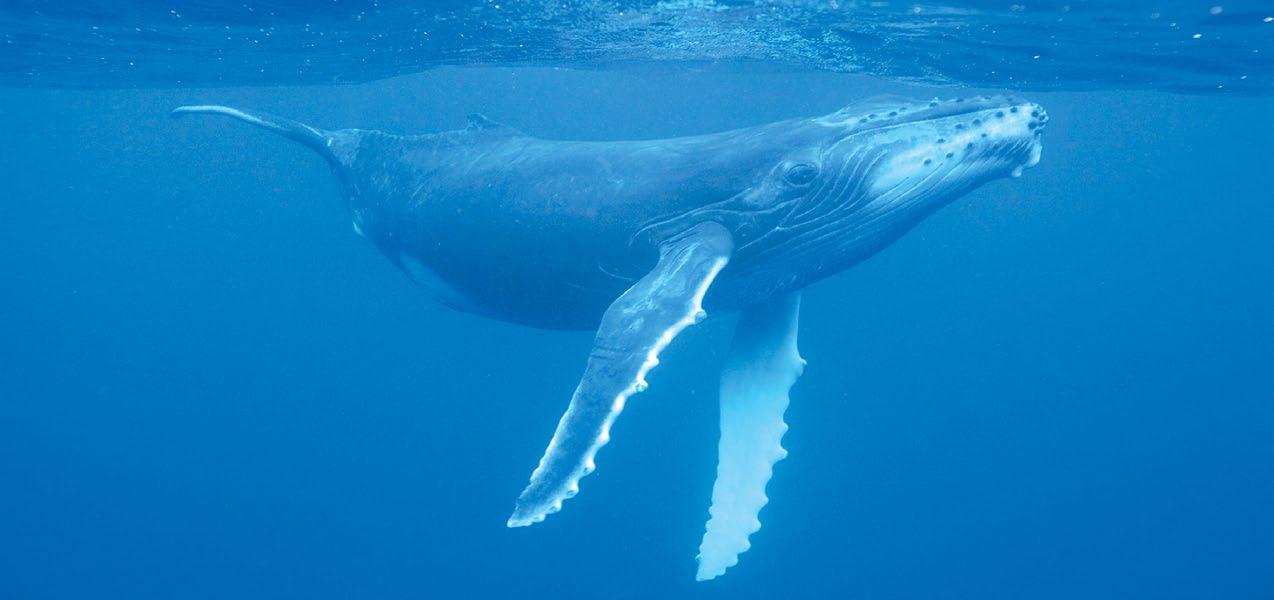
Source: us.whales.org
Originally a long freshwater lake, the Irish Sea, or Muir Eireann is an arm off the Atlantic that separates Ireland from Great Britain. It is believed that this body of water, which is about 120 miles (210km) long and 150 miles (240km) wide, became brackish several million years ago. As regards depth, it reaches around 580 ft (175m) at the Mull of Galloway, so it is relatively shallow. However, there are strong surface currents and tidal streams that enter the Irish Sea from both the north and the south. The two main inhabited islands in the Irish Sea are the Isle of Man and Anglesey. Shipping Most of the goods transported between the UK and Ireland are shipped across the Irish Sea. The largest UK port involved in this trade is Liverpool and its counterpart on the other side is Dublin with its extensive quays on the River Liffey. Northern Ireland also receives a great deal of cargo via this expanse of water, which contributes greatly to the economic worth of the Irish Sea being an estimated $6 billion a year.
Apart from transporting goods, ships operating in the Irish Sea are engaged in fishing and ferrying activities. Herring and whiting are most commonly caught, but cod and flatfish such as halibut are also commercially important. The chief fishing port in the UK in this region is Fleetwood, which is north of Liverpool. In Northern Ireland Ardglass, Portavogie and Kilkeel are the main fishing ports, while Dun Laoghaire, Howth, Skerries and Morrington are the major ports in Eire. Although the fishing industry is still viable, there is a risk that overfishing will cause difficulties.
As far as ferries are concerned, these still cater for millions of passengers a year despite a decline due to lower air fares. Among the ferry connections are Stranraer in Scotland to Belfast and Larne, Holyhead in Wales to Dun Laoghaire and Swansea to Cork. There are also ferries connecting France to Eire. Talks of tunnels and bridges spanning the Irish Sea have been going on for over two decades, but with an accompanying estimated cost of at least €20 billion these talks have not led to construction. Thus, the ferry remains popular with those passengers who travel with their own transport. Environmental Concerns Some areas in the Irish Sea are thought to be dangerously polluted. One type of pollution is radioactive. This originates from waste disposed of at the Sellafield nuclear power station and possibly at Solway Firth due to nuclear powered submarines being serviced at the US Navy base in Faslane between 1960 and 1991. Another area of concern is Beaufort’s Dyke, where chemical weapons are believed to have been dumped. Energy The Irish Sea has oil and gas deposits. Currently, there are almost 20 oil and gas drilling platforms in operation. As for sustainable energy, over 700 wind turbines are either operating or under construction in this region. The Irish Sea may be comparatively small, but it is an important body of water in commercial terms. Its importance may become enhanced after Brexit depending on the outcome of the talks between Britain and the EU. In this light, it may receive more media attention over the coming years.
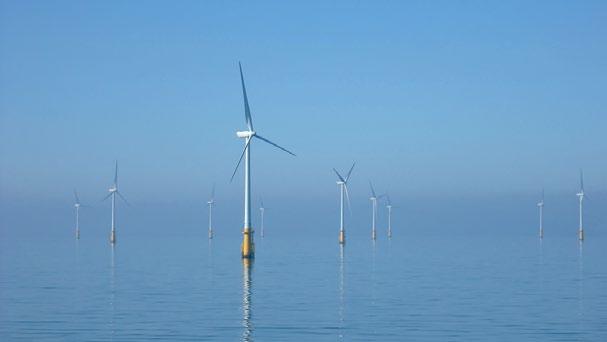
Barrow offshore wind turbines
By Andy Dingley – Source: www.wikimedia.org

One of the more modern ferry boats crossing the Irish Sea
Source: www.freightlink.co.uk
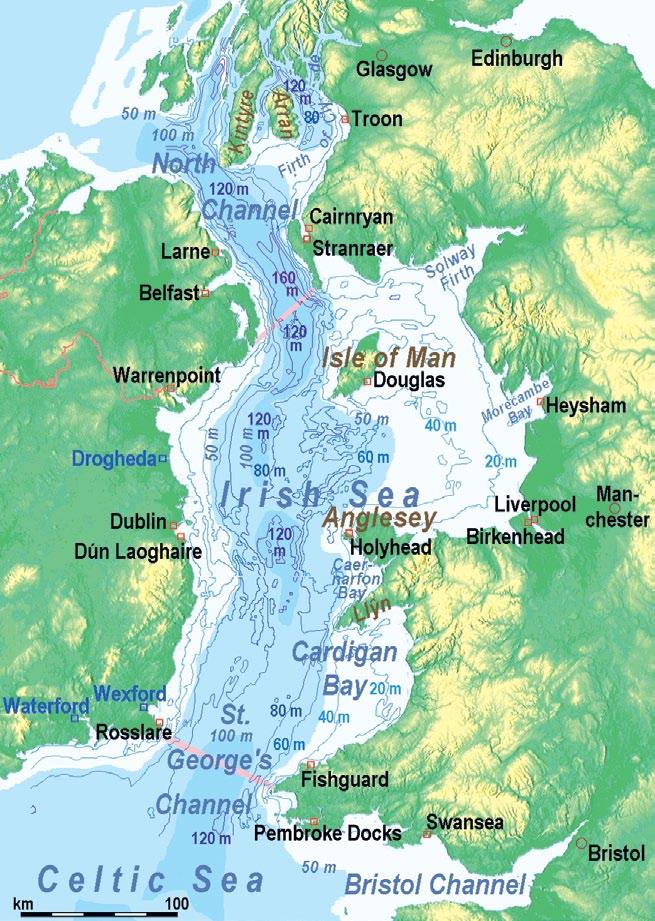
By Ulamm – Source: www.wikimedia.org
Sources: www.britannica.com, www.mcgill.ca, www.worldatlas.com, www.freightlink.co.uk
1. Make the names of two countries using all the letters in the following sentence: I LOVE RED ALARMS, ADA. 2. Which South American capital can have its letters rearranged to make the name of an African country? 3. Which four-letter word can be used to complete the following words: E_ _ _ _ ICITY, BAL_ _ _ _ and P_ _ _ _ IC? 4. In a black bag there are eight cubes. They are all the same size, but no two are the same colour. A person takes out two cubes one after the other, and then puts them back. What are the chances of a second person taking out the same two cubes in the same order? 5. If JY+U=YJU, YJ+U=YUJ and Y+JU=YJU, solve the equation: JY+UJ=? 6. My name can mean something is faulty, And with a certain drink I can be served salty. History shows that I became a saviour To prevent a disease that once threatened a sailor. What am I? 7. The letters in the chemical symbols for aluminium, arsenic and hydrogen can be used to spell the name of a capital city. What is the name of the city? 8. The letters in a Spanish word for ‘the’, the name of a black and yellow stinging insect and the smallest of the Channel Islands off the French coast can be rearranged to form the name of a marine mammal. Which mammal is it?
Test your Brain
Answers at the foot of the page
Quiz
1. After which explorer is a vast ice sheet in the Antarctic named? A James Weddel B Fridjof Nansen C James Clark Ross D Douglas Mawson 2. In line with ISO 8217, what is the minimum flash point of any fuel oil used in machinery spaces? A 50oC B 55oC C 60oC D 65oC 3. Which of the following seas has the lowest average depth? A Mediterranean Sea B Bering Sea C Black Sea D Barents Sea 4. Of all the shipping containers in existence what is the estimated percentage currently being used to transport goods? A 75% B 60% C 45% D 30% 5. To replace lost fluids, it is often recommended that an ORS solution should be drunk. What does the ‘S’ in ORS stand for? A Sugar B Salt C Sweat D Saline 6. The Hudson Bay, River and Strait are all named after a seventeenth-century English explorer. What was his first name? A Henry B Harry C Hubert D Harvey 7. How many decades has it been since the Convention establishing the IMO was adopted? A 4 B 5 C 6 D 7 8. Which port was established by John Law’s Company of the West in 1717? A Los Angeles B New Orleans C San Francisco D New York 9. The Allure of the Seas is now the third largest cruise ship in the world. In which country was she built? A Finland B Germany C Italy D France 10. Consider the latitudes of the ports of Iraklion, Greece; Kawasaki, Japan; Memphis, USA and Tangier, Morocco. How many are within 1o of another? A None B Two C Three D All four
Answers at the foot of the page
Find a keyword associated with at least one article in this issue by solving the clues and rearranging the letters in the boxes with black borders.
1. First submarine under the North Pole (8)
2. A Global Sulphur Cap compliance option (9)
3. Confidence boosting coping statements (8)
4. Makes change more challenging (10)
5. Welsh ferry port (8)
6. Learn to observe like this (11)
7. Country with gig boat clubs (9)
8. Type of unloading system (9) T U
Keyword
Hint: Multiple-perspective approach E R B S
N T V
O
L
F E
U
U M A D
Y
L
Answers
Keyword: HOLISTIC 7. Australia 8. Automatic 5. Holyhead 6. Differently 3. Positive 4. Technology 1. Nautilus 2. Scrubbers KEYWORD SOLUTIONS wasp, Herm) 7. Lhasa 8. Sperm Whale (El, Y=X, W=V and J=I) 6. A lemon 5. YU (Roman numeral system 4. 1 in 56 (0.018) 2. Lima (Mali) 3. LAST 1. ARMENIA, EL SALVADOR TEST YOUR BRAIN answers:
7.D 8.B 9.A 10.D 1.C 2.C 3.D 4.D 5.B 6.A QUIZ answers:
Historic Vessels
Named after the submarine in Jules Verne’s 20,000 leagues under the Sea, the USS Nautilus was the world’s first nuclear powered submarine. Constructed at General Dynamics Electric Boat in Connecticut, she was launched on 21st January 1954. For the first two years, the USS Nautilus took part in experiments to determine the endurance and submerged speed capabilities of a nuclear-powered submarine. She then participated in NATO exercises before embarking on her historic voyage. In April 1958, the USS Nautilus began preparations for her voyage under the North Pole under the command of Willian R. Anderson. The first attempt was thwarted by deep draft ice in the Bering Strait, but the second was a success. The submarine got to the Pole on 3rd August and surfaced in the Atlantic four days later. After joining the 6th Fleet in 1960, the USS Nautilus saw service in the Mediterranean, West Indies and the Atlantic. Two decades on, she was decommissioned and in 1982, the USS Nautilus took up position in Groton Connecticut as a museum ship.
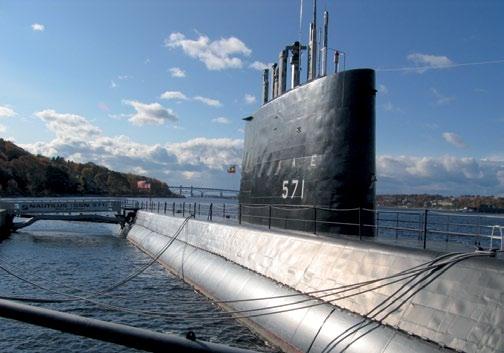
Sources: www.thoughtco.com
USS Nautilus
The USS Nautilus permanently docked at the US Submarine Force Museum and Library, Groton, CT
By Victor-ny, Source: Wikipedia.org
Built at General Dynamics Electric Boat in Connecticut, the USS Triton was launched in August 1958 and commissioned about 15 months later. At 447.5ft (136,4m), the USS Triton was powered by two S4G reactors and the USS Triton only submarine at the time with a twin nuclear reactor plant. Under the command of Captain Edward L. Beach, this iconic nuclear submarine left New London, CT on 16th February 1960. The mission was to circumnavigate the globe submerged with the purposes of increasing technological and scientific prestige, demonstrating the capability of nuclear powered submarines and gaining knowledge of the oceans. The USS Triton left St.Peter and St.Paul Rocks in the Atlantic on 24th February 1960 on a 26,723-mile voyage that would be similar to that accomplished by Magellan in 1519. The Triton returned to the starting point on 25th April 1960. Although the submarine remained submerged, she, or rather part of her, was actually USS Triton Submarine Memorial Park spotted by a teenage fisherman near the Philippines. 19-year-old Rufino By Charles Clark, Source: commons.wikimedia.org Baning saw the sub’s periscope as she came close to the surface. The astonished teenager later described what he saw as a “gleaming mysterious eye” belonging to a giant sea creature. After serving as the flagship for the US Atlantic fleet submarine forces for nearly a decade, the USS Triton was decommissioned in 1969 and as part of the recycling program of nuclear submarines was recycled in 2009. Today, her sail superstructure is on display for visitors to the USS Triton Submarine Memorial Park in Richland, Washington.
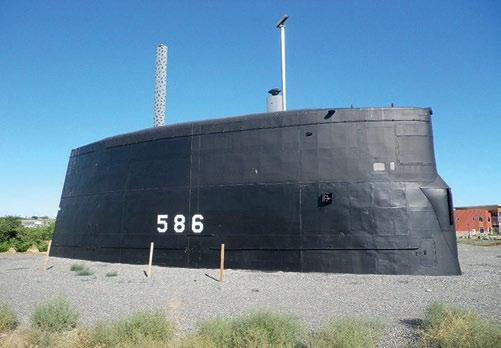
Sources: www.militaryfactory.com, www.edn.com
USS Skate
USS Skate surfaced in Arctic – 1959
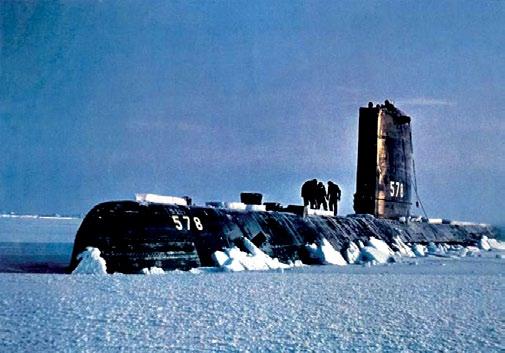
By US Navy photo courtesy of US Navy Arctic Submarine Laboratory. - http://www.navsource.org/archives
Like the USS Triton and USS Nautilus, the USS Skate was constructed in Connecticut. Launched in May 1957, this record-breaking submarine was commissioned seven months later under Commander James F. Calvert. In 1958, she cruised the polar seas along with the USS Nautilus. In March 1959, a crack was observed in the ice above her at the Pole. Using a technique specifically formulated for breaking through surface ice, the USS Skate emerged at the North Pole. In addition to becoming the first submarine to achieve this feat, the discovery that a communications cable floating up against the bottom of an ice sheet could receive radio messages was made on this mission. It is a method of communication still used today. These three record-breaking submarines were a sign of the times. They were Cold War era vessels, whose aim was to allay fears of the perceived threat from the East. Their capabilities as demonstrated in these three feats did this and more. They provided knowledge in the fields of engineering, oceanography communications and psychology, all of which is relevant in the modern era.


